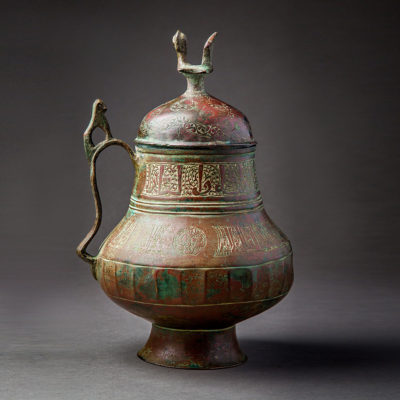
| SKU | FZ.382 |
|---|---|
| Circa | 12th Century AD to 13th Century AD |
| Dimensions | 9.25″ (23.5cm) high |
| Medium | Bronze |
| Origin | Central Asia |
| Gallery Location | UK |
The art of metalwork has been one of the principal forms of artistic expression in the Islamic world. Responding to the taste and needs of different social and economic classes, artists continuously explored the technical and decorative potential of their materials to transform simple, functional objects into highly refined works of art.
In the late tenth century, metalworkers in eastern Iran began to manufacture brass and bronze objects inlaid with designs in gold, silver, and copper. This technique allowed metalworkers “to paint” their vessels with scenes of hunting and feasting—associated with courtly life—astrological signs, and bold calligraphic dedications to rulers. Although the art of inlay was already known in West Asia since at least the sixth century, it reached new levels of artistic and technical sophistication after the arrival of Islam. These vessels are among some of the most powerful expressions of the social, political, and cultural life and aspiration of the individuals and societies for which they were created.
This bronze jug is a glorious example of the mastery of Islamic metalworkers. The shape of the vessel is inherent in its function. However, the decorative elements conform to the shape, creating an elegant and refined appearance without compromising its use. Most prominent are the two stylized animals. While a lion stands proud atop of the pouring handle, a highly abstracted bird rests upon the lid, serving both as a knob and as decoration. A band of cufic text engraved into the bronze and inlaid with silver to highlight the letters adorns the cylindrical top of the jug. This text might be a dedication to the patron of the vessel, it also might be a religious or poetical passage, or perhaps state the identity of the artist. Much like this band interweaves the cufic text with a spiraling pattern of foliage, the vessel as a whole merges the functional form of the jug with the decorative adornments. FZ.382. Jug, cast and hammered bronze with engraved decoration. The globular body on its central part is fluted and rests on a tall splayed foot-ring; sloping shoulder with short and tapering neck, S – shaped elegant handle with a lion sitting on its top as a thumb-piece; the domical lid is capped by a sitting peacock. Engraved floral decorated catouches runs around the shoulder,interrupted by round medallions. A benedictory inscription, written in thuluth runs around the neck. Iran or Central Asia, 12th – 13th century. Prof. Geza Fehervari Prof. Geoffrey King
Login to view price
Sign-up to receive the latest Wedding Estates news and promotions!

